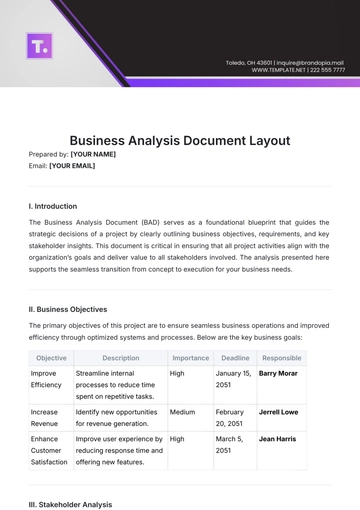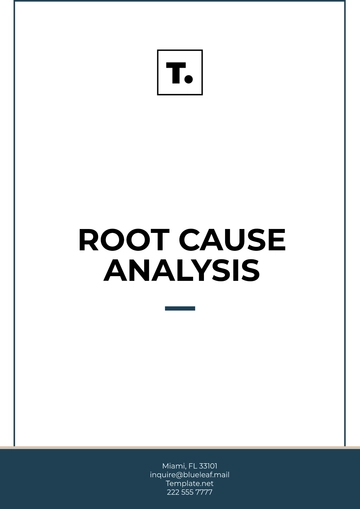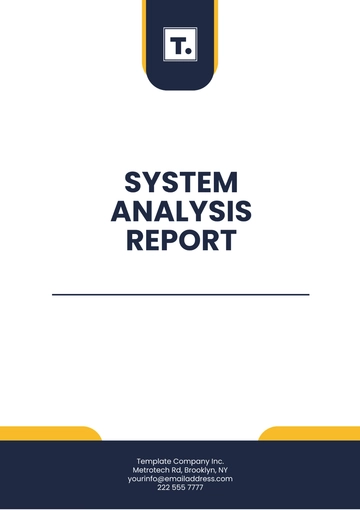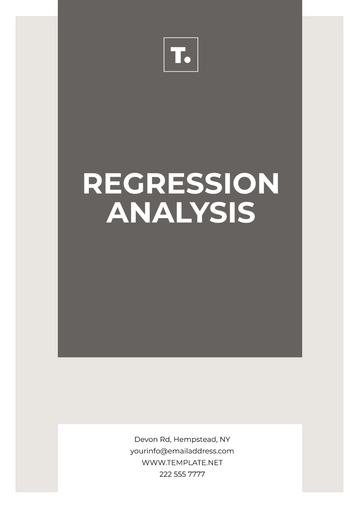Free Marketing Affiliate Opportunities Feasibility Analysis

Executive Summary
In an ever-evolving digital landscape, our company is exploring the feasibility of launching a marketing affiliate program. This analysis delves into the potential opportunities and challenges that such a program could present, with the goal of determining if it is a viable and profitable strategy.
Introduction
The world of marketing is constantly evolving, and affiliate marketing has emerged as a powerful tool for businesses to expand their reach. This analysis will assess the feasibility of introducing a marketing affiliate program within our company, [Your Company Name], and evaluate its potential benefits.
Market Opportunity
Expanding Horizons:
The global affiliate marketing industry is poised for remarkable growth, with a projected market value of $[0.0] billion by [YYYY]. This impressive figure signifies a tremendous growth trajectory that offers promising opportunities for companies seeking to diversify their marketing strategies.
Exploring Diverse Affinity Niches:
The landscape of affiliate marketing is as diverse as it is expansive. It presents a tantalizing array of niches and interests that are ripe for exploration. From the dynamic world of technology to the ever-evolving lifestyle trends, the allure of fashion, and the perpetual concern for health and well-being, there is a niche for every brand. This diversity not only ensures a broad spectrum of potential affiliates but also caters to a wide and varied audience.
Seizing the First-Mover Advantage:
Being an early entrant into this burgeoning market equates to a competitive advantage. It provides an opportunity to harness the current momentum in the affiliate marketing arena and establish a robust foothold before saturation sets in. This first-mover advantage enables us to define industry standards, build influential relationships with affiliates, and ultimately, capture a lion's share of the market.
Business Objectives
Expand Reach: Increase brand visibility and extend our reach to a wider audience.
Boost Sales: Drive sales and revenue growth through affiliate marketing efforts.
Enhance Partnerships: Develop strong relationships with affiliate partners to foster long-term collaboration.
Potential Benefits
Cost-Effective Marketing: Affiliate marketing operates on a performance-based model, reducing upfront marketing costs and aligning expenditures with actual results. This minimizes financial risks and ensures that marketing investments deliver a measurable return on investment (ROI).
Scalability and Adaptability: The beauty of affiliate marketing lies in its adaptability to growth. As our business expands, the program can seamlessly accommodate an increasing number of affiliates and partnerships without the need for a substantial resource or infrastructure overhaul. This flexibility allows us to leverage opportunities for growth while maintaining operational efficiency.
Enhanced Brand Credibility: Collaborating with reputable affiliates offers a compelling means to elevate our brand's credibility and trustworthiness. The endorsements and positive associations created by these affiliations can foster stronger connections with our target audience, establishing us as a trusted and valuable presence in the market. Furthermore, these relationships serve as a powerful testimonial to the quality and reliability of our products and services.
Challenges
Compliance and Ethical Practices: Upholding ethical marketing practices and staying in compliance with the ever-evolving regulatory landscape is not just essential; it's non-negotiable. Navigating this dynamic terrain requires a keen understanding of local and international regulations, which can be complex and subject to frequent changes.
Initial Investment and Cost Structure: While affiliate marketing is renowned for its cost-effectiveness in the long term, the initial setup costs can be a hurdle. Allocating resources for technology, training, and infrastructure is a necessary upfront investment. However, this investment is an investment in the future, as it lays the foundation for sustainable, long-term profitability.
Affiliate Relationship Management: Efficiently managing a network of affiliates is a multifaceted task. It involves not only recruiting the right partners but also nurturing these relationships. This entails tracking performance, providing continuous support, and, sometimes, resolving disputes. It can be labor-intensive but is indispensable for fostering strong, enduring partnerships that drive success.
Target Audience: Ideal Affiliate Profiles
To maximize the success of our marketing affiliate program, we need to precisely identify and engage with affiliates who align with our brand and goals. The ideal affiliate profiles include:
Authority Bloggers and Influencers:
Bloggers and influencers with a substantial and engaged online following in our industry or related niches.
Demonstrated ability to produce high-quality, authentic content that resonates with their audience.
Proven track record of driving engagement, traffic, and conversions through their recommendations.
Niche-Specific Content Creators:
Content creators with a deep understanding of our product/service niche and its nuances.
Demonstrated expertise in creating niche-specific, informative, and engaging content.
A dedicated audience interested in our niche, making them a valuable promotional asset.
Social Media Marketers:
Social media professionals are adept at leveraging platforms like Instagram, TikTok, YouTube, or others.
Proven ability to create captivating visual and multimedia content that sparks engagement.
Track record of using their social media presence to drive conversions and sales.
Program Structure
In order to incentivize top-tier affiliates and ensure the success of our marketing affiliate program, we propose a competitive commission structure. This structure will be designed to attract and retain the most talented affiliates in the industry.
COMMISSION TIERS | AMOUNT |
Standard Affiliates | $10,000 |
Our commission structure is designed with three tiers to reward affiliate performance. Standard Affiliates, generating up to $10,000 in monthly sales, earn a base 10% commission. Elite Affiliates, exceeding $10,000 in monthly sales, unlock a higher 15% commission tier, emphasizing our commitment to excellence. The Super Affiliates consistently achieving monthly sales surpassing $25,000 enjoy an impressive 20% commission rate, marking them as exceptional contributors to our program's success.
Additional Incentives
In addition to the commission structure, we will offer performance-based incentives such as:
Performance Bonuses: Affiliates hitting predefined milestones (e.g., achieving a certain number of conversions or maintaining a high conversion rate) will receive bonuses, creating further motivation for excellence.
Revenue Share: On top of standard commissions, we will consider offering revenue share options to our most successful affiliates, allowing them to share in the company's long-term success.
Financial Projections
Initial investment: $50,000
[The initial investment of $50,000 for our marketing affiliate program sets the stage for impressive revenue growth over the next four years. Year 1 is expected to yield $500,000, representing a tenfold return on the investment. In Year 2, revenue is projected to more than double to $1,200,000, demonstrating the program's scalability. By Year 3, we aim to reach $2,500,000, reflecting steady progress.
In Year 4, our optimistic projection of $4,200,000 is based on factors such as expanding our affiliate network, introducing new products, improving conversion rates, enhancing brand visibility, and effective affiliate management, ensuring continued growth and profitability.]
Implementation Timeline
The implementation timeline for the marketing affiliate program spans over a year, with distinct phases:
Months 1-3: Program Planning and Platform Setup
In the initial three months, the focus will be on strategizing and setting up the infrastructure for the affiliate program. This phase involves creating the program's framework, establishing tracking systems, and developing marketing collateral.
Months 4-6: Recruitment of Affiliates and Onboarding
The subsequent three months are dedicated to recruiting high-quality affiliates who align with our brand and values. This phase involves outreach, negotiations, and onboarding processes, ensuring affiliates are well-prepared to represent our brand.
Months 7-12: Launch and Ongoing Management
The final six months mark the launch of the affiliate program, with an emphasis on continual monitoring, performance optimization, and relationship management with affiliates. Ongoing management ensures the program's sustained success and growth.
Risk Assessment
In our pursuit of a marketing affiliate program, a comprehensive risk assessment is vital to prepare for potential challenges and mitigate their impacts effectively.
Market Saturation:
Intensive competition within specific niches poses a risk to affiliate recruitment efforts. Highly saturated markets may result in difficulties in attracting top-tier affiliates.
Mitigation: We will conduct extensive market research to identify underserved or emerging niches and tailor our recruitment strategy to focus on those areas, offering competitive advantages in less crowded sectors.
Regulatory Changes:
Changes in advertising regulations at local, national, or international levels may directly impact our affiliate program's compliance, potentially leading to legal complications or fines.
Mitigation: Establishing a robust compliance and legal team dedicated to monitoring and adapting to regulatory changes is imperative. Regularly educate affiliates about compliance requirements and maintain open lines of communication to address any evolving legal landscape promptly.
Quality Control:
The behavior and practices of affiliates can significantly influence our brand image. Ensuring that affiliates consistently represent our brand accurately and ethically is crucial.
Mitigation: Implement a strict onboarding process, guidelines, and regular audits to maintain brand consistency. Foster a strong working relationship with affiliates by providing clear expectations and offering resources to help them align with our brand's values and messaging. Implement a tiered performance-based system to encourage ethical representation of the brand.
CONCLUSION
The prospect of launching a marketing affiliate program holds immense potential for driving growth and expanding our brand reach. The risk assessment and mitigation strategies laid out in this analysis underscore our commitment to tackling challenges head-on while leveraging the numerous benefits of this dynamic strategy.
While we acknowledge the challenges presented, it's essential to remember that these can be successfully navigated with strategic planning and diligent management. As the saying goes, "With great risks come great rewards," and this venture embodies that sentiment.
The next steps on our journey should encompass the creation of a comprehensive business plan, the recruitment of a dedicated affiliate program manager who can steer this initiative, and conducting in-depth market research to pinpoint the most lucrative and unexplored niches. With these foundations in place, we are well-positioned to harness the power of affiliate marketing and steer our brand towards new heights of success.
Marketing Templates @ Template.net
- 100% Customizable, free editor
- Access 1 Million+ Templates, photo’s & graphics
- Download or share as a template
- Click and replace photos, graphics, text, backgrounds
- Resize, crop, AI write & more
- Access advanced editor
Explore the Marketing Affiliate Opportunities Feasibility Analysis Template on Template.net! This editable and customizable resource aids in assessing the viability of affiliate programs. Tailor it effortlessly to your requirements using our Ai Editor Tool. Gain insights to optimize affiliate marketing strategies and maximize revenue potential. Elevate your affiliate marketing efforts with ease.





























